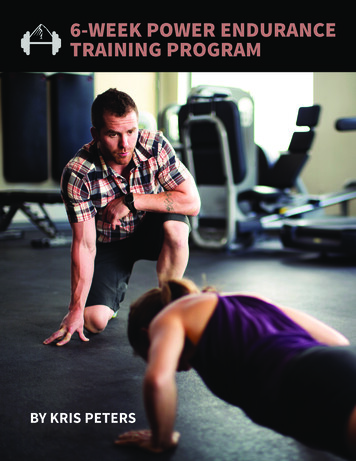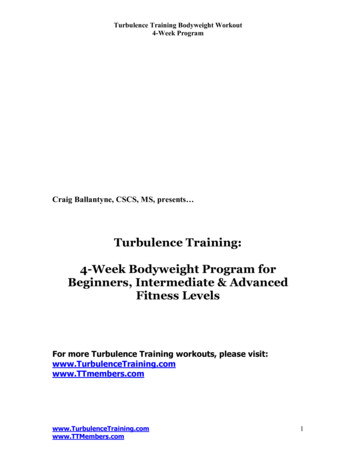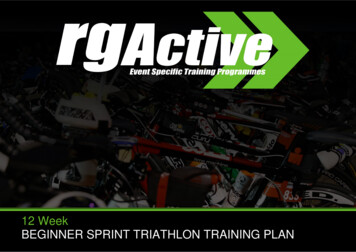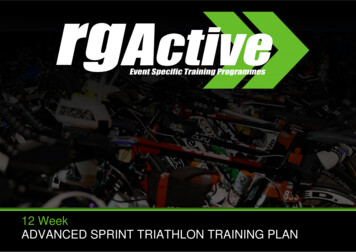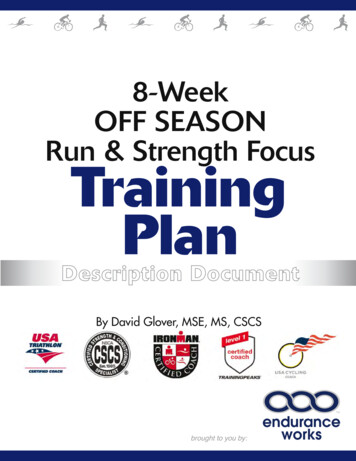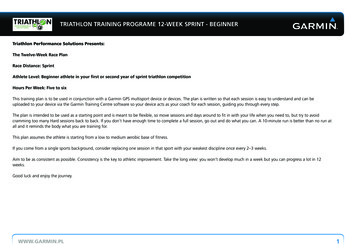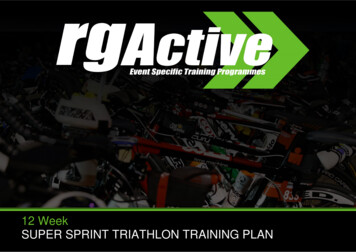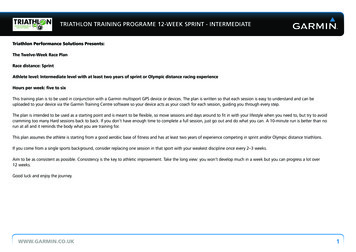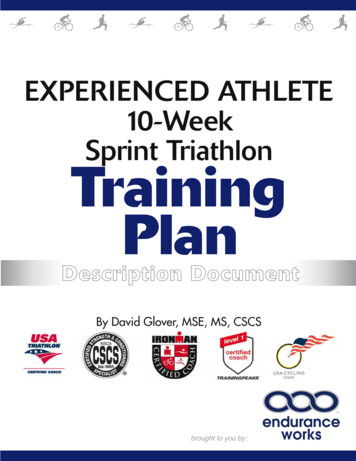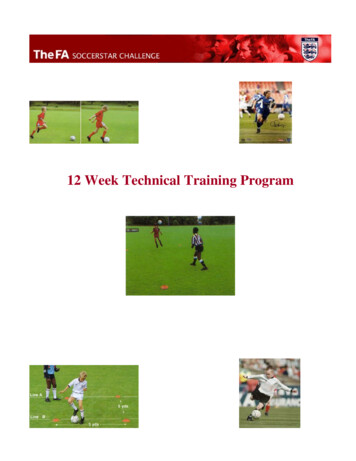
Transcription
12 Week Technical Training Program
GreetingsAs you decide to become a better soccer player you must be responsible for your own development.Don t use your own situation as an excuse as to why you are not developing. Improve yourself no matterwhat. You are in control. If you follow this program, you will be a much improved soccer player and youwill be developing the self-responsibility and self discipline needed to improve your technique.This is a 12 week program that is designed specifically for you. It is based on your F.A soccer starchallenge performance. Completion of the program is a minimum of 3 days completed per week. You cantrain as much as you want each day but one day can only count as one day. You cannot do 3 days ofworkouts in one day and count it as 3 days. Use your creativity to work on the assigned skills. This is yourchance to improve your skills and be a much improved player. Only you can decide.How it works:The program has a minimum of 3 individual workouts per week and a maximum of 5. Eachworkout is approximately 40 minutes and involves 10 minutes of juggling and 3 different activities of 10minutes each.When you are ready to do a session, follow the schedule for Day 1 of that week. After you ve donethat, check off day 1. The next day you want to do something, follow Day 2 s schedule. If you wait 3 daysbetween sessions or go the next day, you still do Day 2. The next time Day 3, etc. If you do a session everyday of that week, you will only have 5 days for that week. Regardless, the next week, you ll start on Day 1of the next week. If you want to do more, do each section longer or work on additional skills, but youcannot check off more than one day per day.Upon completion of the 12 week program you will have logged six hours of juggling and over 10hours of: running with the ball, turning with the ball, speed technique, dribbling with the ball, heading, andshooting. Once completed, you and a parent/guardian must sign the program checklist. Return the checklistto Antonio Sabio, your SYSO director of coaching. SYSO will recognize players for completion of thestandard program (3 days a week for 12 weeks).You will need a soccer ball, a wall to kick against, and something to use as cones.Before you start a training session:Pay attention to the key factors for each technique.Set yourself a daily target for each technique (i.e. 130 juggles)After you have completed a training session:Attempt these techniques in games.Watch other players execute these techniques.2
A) JugglingStart each training session with 10 minutes of juggling. Change the type of juggling at least every 3minutes, so you can stay focused and interested. The goal is always 100 juggles, which is a goodindicator of mastery. Use the grid below to record your juggling highs:Did you know? The world record for heading a tennis ball (without the ball touching the ground) is heldby Tomas Lundman of Sweden who lasted exactly one hour on 31st December 2002.Key Factors For Success:Have a loose upper body and keep your arms out for balance.Kick the ball back to your hands with your foot cocked at a 90-degree angle.Lock your ankle and replant on each AlternatingfeetHigh juggling(above head)Low juggling(below waist)AlternatingHigh/LowAlternatingFoot/ hLeft footRight footJuggling whilejoggingSmall balljuggling3
B) Running with the ballTry to run the ball around the grid(s) as quickly as possible (measured to a tenth of a second) OR bytaking as few touches as possible. If the ball crosses any line of the grid you must start over.Remember, running with the ball involves moving the ball across areas that do not containdefenders. It could also be used to accelerate away from opponents.Mark out an area 30 x 30 yards. You will also need to use an 18 yard box, half field (57 x 75), and afull field (115 x 75 yards) to practice running with the ball over different distances. Similarly, youcan use your own distances.Use the grids on page 5 to record your best scores for each week.Key Factors For Success:Take 1st touch out in front.Use the outside of the foot to kick the ball.Take a few long touches.Keep your head up.Run in a straight line.4
Running with the EEK6WEEK7WEEK8WEEK9WEEK10WEEK11WEEK1218 yard box.30 x 30 gridHalf field(57 x 75)Full field(115 x 75)Time (sec)18 yard box.30 x 30 gridHalf field(57 x 75)Full field(115 x 75)5
C) Turning with the ballTry to execute as many turns as possible in the time allotted. Use the same turn or combination ofturns.Mark out a grid 5 x 5 yards. Start in the center. Dribble across any side of the square and execute aturn (change of direction), and accelerate back into the square (change of speed).Choose 2 or 3 of the following turns to practice for the time allotted. Choose different turns eachtime you practice turning with the ball.Use the grids on page 9 to record your best scores for each week.i) Hooking the ball with the inside of the foot (2-3 minutes)Reach and hook to turn the ball. Don t run around the ball. Move the ball on the turning touch back in thedirection you want to go.ii) Hooking the ball with the outside of the foot (2-3 minutes)Reach and hook to turn the ball. Don t run around the ball. Move the ball on the turning touch well in frontof you, back in the direction you want to go.6
iii) Step-over turn (2-3 minutes)Take your right foot and step around the ball from the outside to the inside. Swivel your hips and play theball back with the inside of your other foot - you fake going left and then you go right.iv) Drag-back turn (2-3 minutes)Use the sole of the foot to stop the ball and change direction.7
v) Stop-turn (2-3 minutes)Trap the ball under the foot, turn your body, quickly play the ball with the other foot.vi) Cruyff turn (2-3 minutes)Fake a shot with your right foot and swing your foot past the ball to the right side. Turn right foot inwardwith toe down and push the ball behind and away from you so it goes between your legs. Now you candribble in the other direction.Key Factors For Success:Start slowly.Execute turn (change of direction).Bend your knees.Accelerate away (change of speed).Show some disguise when turning.8
Turning with the ball5x5(30 sec)Inside K7WEEK8WEEK9WEEK10WEEK11WEEK12Outside hookStep overDrag backStop turnCruyffCombination5x5(60 sec)Inside hookOutside hookStep overDrag backStop turnCruyffCombination9
D) SpeedSpeed is a motor task which can be learned and improved through practice like any other skill. Insoccer, this is accomplished by learning the correct movement mechanics without the ball. Thereare two exercises to choose from:Quick Foot Ladder (7 minutes)Mark out a ladder with chalk or tape, or buy one. Each box is about 1 foot by 1 foot.Start at one end and move through the ladder. The aim is to complete each sequence correctly andas quickly as possible. Complete a sequence 3 times before moving onto the next one.Start locationEnd location1) Run through the ladder placing one foot in the middle of each square.2) Run through the ladder touching both feet in each square.3) Work along the ladder placing both feet in each square (see below).Fig 3aFig 3bFig 3cFig 3dFig 3eBegin by standing sideways to the ladder (Fig 3a)Moving in a lateral fashion to your right, step into the first square with the right foot (Fig 3b)Step in with the left foot (Fig 3c)Step back out with the right foot (Fig 3d)Step back out with the left foot (Fig 3e)Repeat the sequence from 2 to 5 all the way along the ladder10
Four square plyometric pattern (7 minutes)Mark out a box with chalk, tape, or cones. Each line is 48 inches long.Start at square 1 and jump in the order required. It is important that you face forward and place yourfoot flat on the ground when completing the patterns. Count each time you return to the startingpoint. For example, when going from box 1 to box 2 to box 1, you would count each time you hitbox 1. If your foot touches any part of the tape/cone or you miss a square, the repetition does notcount.Use the grids on page 12 to record your best scores for each pattern. The patterns on page 12 can bereduced, expanded, or changed to fit your overall abilities and needs. You are limited only by yourimagination.2314Key Factors For Success:Keep your arms out for balance.Keep your hips over the feet.Have a loose upper body.Be light on your feet.Keep a low Center of gravity.11
SpeedSingle leg(left)10 EK4WEEK5WEEK6WEEK7WEEK8WEEK9WEEK10WEEK11WEEK12BOX 1-2BOX 1-3BOX 1-4BOX 4-2BOX 1-2-3BOX 1-4-2Single leg(right)10 secondsBOX 1-2BOX 1-3BOX 1-4BOX 4-2BOX 1-2-3BOX 1-4-2Both legs20 secondsBOX 1-2BOX 1-2-3BOX 1-3-2BOX 1-2-3-4BOX 4-2-1-3BOX 1-4-2-312
E) DribblingTry to dribble past/around as many cones as possible in the allotted time. For cone weaving andcloverleaf weaving try to complete as many circuits as possible in the time allotted.Mark out an area approximately 30 X 30 yards and place 8 cones randomly inside the grid. Conesshould be at least 3 yards apart. Try to imagine that the markers are defenders. The moves listedwill help you make progress in your dribbling technique.Choose 2 or 3 of the following dribbling techniques to practice for the time allotted.Use the grids on page 15 to record your best scores for each week.X---10 yards---XxXXxxXXxxxXxXxXXStanley Matthews (2-3 minutes)Move the ball with the inside of your right foot to your left side and fake to go to your left, by leaning tothe left. Move your right foot quickly behind the ball so that the outside of your right foot is behind the ball.Accelerate away to your right using the outside of your right foot to push the ball past the marker.Scissors (2-3 minutes)Play the ball out in front of your right side. Pretend to play the ball with the outside of the right foot butstep over the ball with your right foot. Take the ball away with the outside of your left foot past the marker.13
Double touch (2-3 minutes)Pretend to be about to play the ball to your right with the inside of your right foot - your upper body shouldbe at an angle. Draw the ball across the body with the inside of your right foot. Take the ball away to yourleft side with the inside of your left foot past the marker.Cone weaving (2-3 minutes)XXXXX- 3 yards -Dribble around the cones (X s) using your left foot only, right foot only, both feet, outside of your footonly, inside of your foot only, or a combination of everything.Cloverleaf cone weaving (2-3 minutes)XX 3 yards-XXXDribble around the cones (X s) in the sequence shown in the diagram. Use your left foot only, right footonly, both feet, outside of your foot only, inside of your foot only, or a combination of everything.Key Factors For Success:Begin slowly.Keep close control.Keep your head up.Bend your knees.Execute turn (change of direction) and accelerate away (change of speed).Show some disguise when turning.14
DribblingDribbling(20 WEEK12MatthewsScissorsDouble touchCombinationDribbling(40 sec)MatthewsScissorsDouble touchCombinationConeweaving(circuits)Left footRight footBoth feetCombinationCloverleaf(circuits)Left footRight footBoth feetCombination15
F) HeadingTry to: head the ball as many times as you can, head as far as you can, or score as many goals asyou can.You will need a partner or a high wall to practice heading.Choose 2 of the following 5 exercises to practice for the allotted time.Use the grids on page 18 to record your best scores for each week.Head juggling (3-4 minutes)Keep the ball about 2 feet above your head.Head juggling with a partner (or against a wall) (3-4 minutes)Have a partner serve you a ball. The serve should be underarm and two handed. Head the ball back to yourpartner and record how many times you and your partner can head the ball without it bouncing. You canuse a wall if you have no partner.16
Offensive header - with a partner - (3-4 minutes)Have a partner serve you a ball in the air (approximately 10 yards apart). The serve should be underarm andtwo handed. Get in line with the ball. Head through the top half of the ball so it goes downward. Try tohead the ball past your partner. You partner must stay on the goal line (10 yards) and can t use his/herhands to defend. However, before you score the ball must first bounce. If you have no partner you can use awall to practice this technique.Defensive headerwith or without a partner - (3-4 minutes)Have a partner serve you a ball high in the air (approximately 15 yards apart). The serve should beunderarm and two handed. Get in line with the ball. Head through the bottom half of the ball so it goes up.Try to head the ball high to your partner. Record how many times you and your partner can head the ballwithout it bouncing. You can use a wall if you have no partner.Try increasing the distance between you and your partner. Measure the distance you can head the ball.Key Factors For Success:Keep your eyes open.Use your forehead to head the ball.Keep your arms out for protection and balance.Head through the top half of the ball (Attacking headers)Head through the bottom half of the ball (Defensive headers)17
K5WEEK6WEEK7WEEK8WEEK9WEEK10WEEK11WEEK12WEEK1
12 Week Technical Training Program. 2 Greetings As you decide to become a better soccer player you must be responsible for your own development. Dont use your own situation as an excuse as to why you are not developing. Improve yourself no matter what. You are in control. If you follow this program, you will be a much improved soccer player and you will be developing the self-responsibility .

